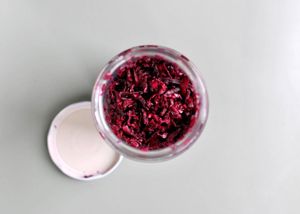I like to joke that the reason my boyfriend was the perfect faecal-transplant donor was because he was born in Germany, the land of sauerkraut. I grew up in New Zealand, where the ’80s and ’90s diet, at least as far as I experienced, was basically devoid of naturally fermented foods. Add in a healthcare system that hands out antibiotics as if they were vitamin pills, and you’ve got a recipe for gut disaster.
While I didn’t know about sauerkraut back then – and, quite frankly, would have probably vomited in my mouth a little if someone suggested I eat fermented cabbage – I sure as hell know about it now. I tend to rotate between a few fermented-cabbage favourites: sauerkraut (purple or green*) and kimchi (recipe to follow later). The former is great as a side for wintry stews or as a garnish for fresh summer salads. The latter I tend to use as a side for Asian dishes – perhaps on top of some stir-fried vegetables and soba noodles, for example. Or, my guilty pleasure: a kimchi-and-cheese toasted sourdough sandwich.
* For green sauerkraut, skip the beetroot (or add yellow or white beets instead). If skipping the beets, use double the amount of cabbage. The apple is optional either way
** After having a few batches of sauerkraut remain super salty and never properly ferment, I presumed I was basically preserving the cabbage with too much salt. A dive into Ferment for Good by Sharon Flynn offers this advice: The amount of salt you use should come to about 1.5-2.5%, but no more than 3% of the [produce] weight.
